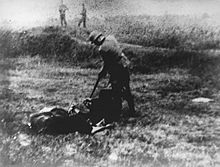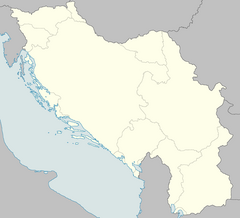Banjica concentration camp
| Banjica | |
|---|---|
| Concentration camp | |

A German soldier points his rifle at a prisoner in Jajinci, which served as an execution site for Banjica inmates.
|
|
| Coordinates | 44°46′15″N 20°28′03″E / 44.77083°N 20.46750°ECoordinates: 44°46′15″N 20°28′03″E / 44.77083°N 20.46750°E |
| Location | Banjica neighbourhood, Belgrade, Territory of the Military Commander in Serbia |
| Operated by | Gestapo, Belgrade Special Police and Serbian State Guard |
| Operational | 5 July 1941 – 3/4 October 1944 |
| Inmates | Primarily Serbs, Jews, Roma and anti-fascists |
| Number of inmates | 23,697 |
| Killed | At least 3,849 |
The Banjica concentration camp (German: KZ Banjica) was a Germanconcentration camp in the Territory of the Military Commander in Serbia during World War II. Located in the Banjica neighborhood of Dedinje—a suburb of Belgrade—it was originally used by the Germans as a center for holding hostages. The camp was later used to hold Serbs, Jews, Roma, captured Partisans, Chetniks and other opponents of Nazi Germany. By 1942, most executions occurred at the firing ranges at Jajinci, Marinkova Bara and the Jewish cemetery.
Banjica was operational from July 1941 to October 1944. It was jointly run by German occupying forces under the command of Gestapo official Willy Friedrich. Later, Friedrich was tried, found guilty and executed for war crimes by Yugoslavia's post-war communist authorities. 23,697 individuals were detained in Banjica throughout the war, at least 3,849 of whom perished. After the war, a small monument dedicated to the victims of the camp was constructed. The Museum of the Banjica Concentration Camp was opened in 1969, and contains more than four hundred items relating to the camp and its operation.
Following the 1938 Anschluss between Germany and Austria, Yugoslavia shared a border with the Third Reich and came under increasing pressure as her neighbours aligned themselves with the Axis powers. In April 1939, Italy opened a second frontier with Yugoslavia when it invaded and occupied neighbouring Albania. At the outbreak of World War II, the Yugoslav government declared its neutrality. Between September and November 1940, Hungary and Romania joined the Tripartite Pact, aligning themselves with the Axis, and Italy invaded Greece. From that time, Yugoslavia was almost completely surrounded by the Axis powers and their satellites, and her neutral stance toward the war became strained. In late February 1941, Bulgaria joined the Pact. The following day, German troops entered Bulgaria from Romania, closing the ring around Yugoslavia. Intending to secure his southern flank for the impending attack on the Soviet Union, Adolf Hitler began placing heavy pressure on Yugoslavia to join the Axis. On 25 March 1941, after some delay, the Yugoslav government conditionally signed the Pact. Two days later, a group of pro-Western, Serbian nationalist Royal Yugoslav Air Force officers deposed the country's regent, Prince Paul, in a bloodless coup d'état, placed his teenaged nephew Peter on the throne, and brought to power a "government of national unity" led by General Dušan Simović. The coup enraged Hitler, who immediately ordered the country's invasion, which commenced on 6 April 1941.
...
Wikipedia

